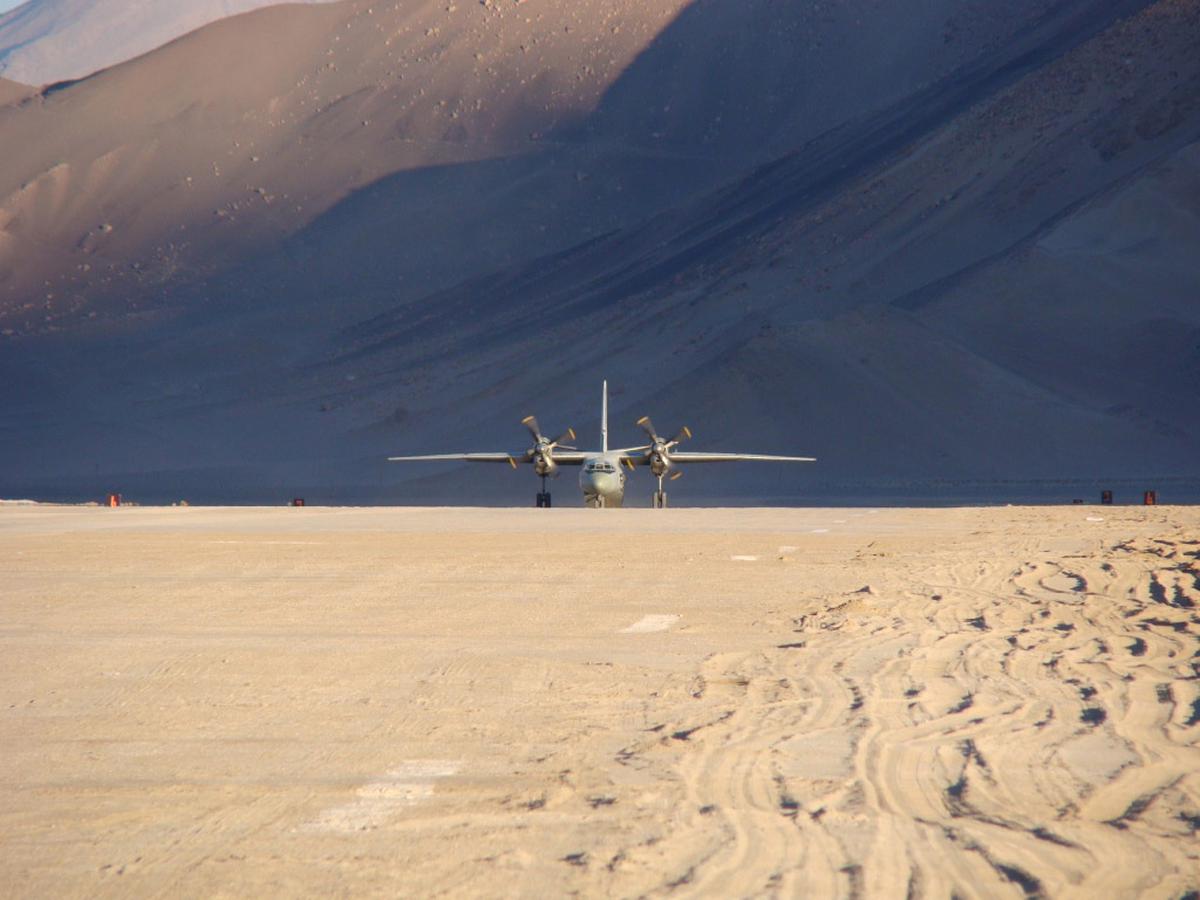Nyoma advanced landing ground in eastern Ladakh is being upgraded to handle fighter jets
Context
Defense officials revealed that this week saw the start of construction on the extension of the Advanced Landing Ground (ALG) at Nyoma in eastern Ladakh as part of the ongoing development of infrastructure along the Line of Actual Control (LAC). The runway will be extended past 9,000 feet, enabling it to accommodate fighter jets. According to a source, the Indian Air Force (IAF) is also modifying fighter jet engines to enable high-altitude starting.
What kind of development is happening in Nyoma?
- Nyoma is located in the Union Territory of Ladakh in northern India’s eastern Ladakh area. It is situated at a high elevation of roughly 4,175 meters (13,700 feet) above sea level.
- The Line of Actual Control (LAC), which divides India and China, is not far from Nyoma. It is strategically placed close to the south bank of the high-altitude lake Pangong Tso, which has served as the focal point of border disputes between China and India.
- Nyoma has grown in significance as an Advanced Landing Ground (ALG) for military operations and air connectivity in the area due to its position and altitude.
- With the help of the expansion project, Nyoma’s ALG’s concrete runway will be able to support fighter jets by being increased to over 9,000 feet.
- Due to the short working seasons in the high-altitude region, it is anticipated that the project will take two to three years to complete.
- The Nyoma ALG expansion is a part of India’s overall infrastructure development initiatives along the Line of Actual Control (LAC) in the eastern Ladakh region.
- In order to start fighter jet engines in high-altitude regions with exceptionally low temperatures—which can drop as low as minus-40 degrees Celsius during the winter—the Indian Air Force (IAF) has modified them.
- Nyoma is an essential place for military operations and observation, especially amid border tensions, due to its strategic location close to the south bank of Pangong Tso and its proximity to the LAC.
- The changes in Nyoma represent India’s proactive strategy to improve its military facilities and capabilities in response to strategic dynamics near its border with China.
What was the need for this project ?
- Enhancing Military Air Operations: The ALG can handle fighter jets now that the runway has been extended to nearly 9,000 feet. The Indian Air Force (IAF) will be better able to perform military air operations in the area, such as quick deployments, surveillance, and reconnaissance missions, thanks to this capacity.
- Operations at High Altitude: Nyoma is located at an elevation of around 13,700 feet (4,175 meters). Fighter planes’ engines must be modified in order for them to start and function properly at such high altitudes, when temperatures can drop to dangerously low levels. With this improvement, the IAF is now able to continue operating in these difficult circumstances.
- Border Security and Surveillance: Nyoma’s proximity to the Line of Actual Control (LAC) with China makes it strategically important for border security and surveillance. The expanded ALG can support the deployment of aircraft for intelligence gathering, monitoring, and maintaining situational awareness along the border.
- Strategic Flexibility: The expansion of Nyoma’s ALG enhances India’s strategic flexibility by establishing a strong air presence closer to the border, allowing for quicker response times in case of emerging situations or threats.
- Infrastructure Development in Eastern Ladakh: After the LAC tensions pick up in 2020, India’s presence and capabilities in the region will be strengthened through the building of military infrastructure, including ALGs, roads, and other amenities.
- Counterbalancing China’s Developments: In order to safeguard its territorial integrity and establish a balanced military posture, India is likewise investing in improving its own infrastructure in reaction to China’s infrastructure expansions along the LAC.
What is the strategic importance of Nyoma ALG?
- Proximity to Line of Actual Control(LAC):Nyoma is situated in eastern Ladakh and is close to the Line of Actual Control (LAC), which divides India from China. Due to its advantageous location, it is an essential tool for keeping an eye on border developments and responding to them.
- Rapid deployment and reaction: Nyoma ALG’s runway has been extended to make room for fighter jets. As a result, the Indian military is better able to quickly deploy aircraft to deal with emergency circumstances, perform reconnaissance, and guarantee a prompt resolution of any security issues along the LAC.
- Enhanced Air Operations: Nyoma ALG can accommodate a range of military aircraft, including fighter jets, thanks to the enlarged runway. A larger range of aviation operations, such as air patrols, surveillance missions, and possibly even air defense operations, are supported by this capacity.
- High-Altitude Operations: The thin air and harsh temperatures at Nyoma’s high altitude provide operating difficulties. India’s position in a difficult environment is strengthened by the upgrades made to fighter aircraft engines to permit continuous air operations.
- Defense and Deterrence: Having a working ALG at Nyoma serves to deter possible enemies and strengthens India’s resolve to protect its borders. Additionally, it serves as a hub for defensive air operations in the area.
- Strategic Flexibility: By offering an operational base nearer the Chinese border, Nyoma ALG gives India more strategic flexibility. This adaptability enables military positions to be changed quickly in response to shifting security dynamics.
- Surveillance and Intelligence:The ALG’s location makes it easier to conduct operations for aerial surveillance and intelligence gathering near the border. This aids in keeping situational awareness and tracking the movements of adversaries.
- Support During Stand-Offs: Nyoma’s ALG was used in the 2020 stand-off with China, highlighting its function in assisting military operations and logistics in time of need.
What are China’s Infrastructure Development?
- Along the LAC in the area, China has refurbished and constructed additional airfields, as well as dual-use airfields, roadways, troop housing, and munitions depots.
- The status quo along the LAC has changed as a result of China’s attempts to improve infrastructure, which has an effect on the strategic equilibrium in the area.
What are the challenges faced by the Army ?
- In order for equipment and vehicles to operate properly in high-altitude settings, they must be modified to withstand the harsh weather conditions. For instance, K9 Vajra self-propelled howitzer “winterization” kits were purchased by the Indian Army.
What is Chinese measures in response to our development?
- In response to India’s strategic actions, China has improved the roads and strengthened other routes near its Moldo fortress near Pangong Tso to lessen vulnerabilities.





